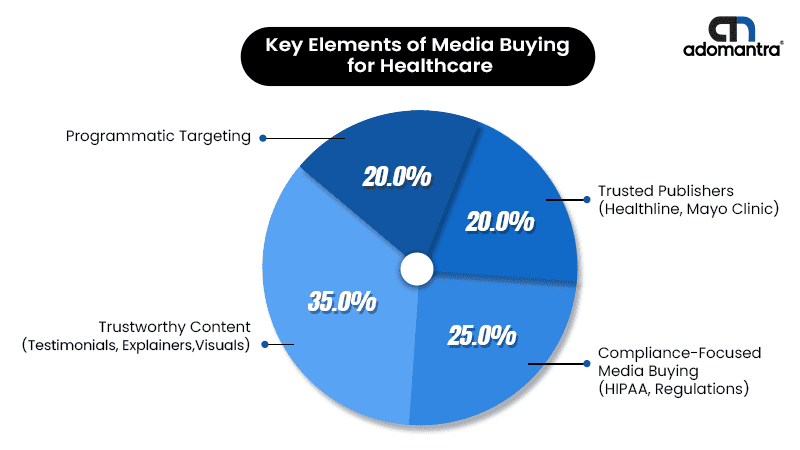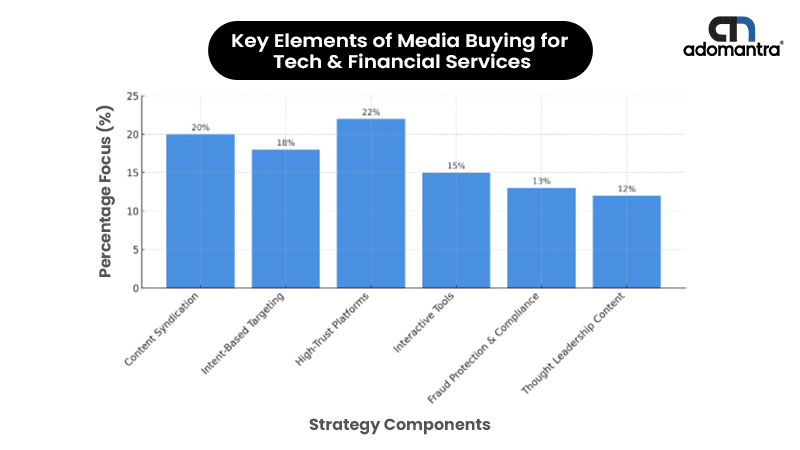
Every brand fights for attention—but only the relevant ones win. In a world flooded with content, media buying isn’t just about visibility. It’s about being precise, purposeful, and profitable. That’s why a one-size-fits-all approach no longer works. If your campaigns aren't tailored to your industry's unique landscape, you're not just losing money—you’re losing momentum.
Whether you’re in tech, healthcare, finance, education, retail, automotive, real estate, hospitality, or FMCG, one truth stands out: a refined media plan outperforms a generic one every time. According to Nielsen, optimized digital campaigns can deliver 35% stronger returns on ad spend. Meanwhile, HubSpot’s 2023 report found that companies updating their media plans monthly cut wasted ad spend by 28%.
Here's how media buying varies by industry—and how tailoring your approach drives better outcomes!
Media Buying for B2B: Precision, People, and Performance

Media buying for B2B requires a laser-focused strategy. You’re not selling to everyone—you’re reaching decision-makers who are pressed for time and need quick, clear value. According to Demand Gen Report, 72% of B2B buyers expect content tailored to their industry and job role.
Use platforms like LinkedIn, Google Ads, and programmatic DSPs to target specific roles, industries, and intent signals. Pair this with marketing automation tools like HubSpot or Marketo to nurture leads through the funnel.
Share content that speaks their language—whitepapers, use cases, executive webinars, or ROI calculators. Skip the fluff. Prioritize value. Your media buying strategy must guide them from awareness to decision with purpose.
Media Buying for Healthcare: Build Trust, Stay Compliant
In a highly regulated and sensitive space like healthcare, trust is everything. Media buying for healthcare must be transparent, informative, and aligned with strict compliance standards.
Use programmatic media buying with HIPAA-compliant targeting. Trusted publishers like Healthline and Mayo Clinic provide access to intent-rich audiences without sacrificing brand safety.
Content should answer questions, not push products. Use patient testimonials, doctor explainers, and visual storytelling to drive relevance. Empathy sells better than promotion in this vertical.
Media Buying for Retail: Speed, Seasonality, and Sales

In retail, timing is everything. Media buying for retail must keep pace with demand spikes, flash sales, and shifting consumer behavior. Statista reports that 43% of retail marketers now use AI-driven tools to optimize ad delivery in real time.
Use platforms like Google Shopping, Meta Ads, and influencer marketing networks for visibility across every touchpoint. Dynamic creatives, geo-targeting, and remarketing are your best allies for high conversion rates.
Don’t wait to analyze results—test often and pivot fast. Promote inventory levels, pricing drops, and urgency-driven campaigns. Your media buying strategy should drive instant action.
Media Buying for Education Sector: Connect with Lifelong Learners
From Gen Z college seekers to working professionals eyeing online degrees, media buying for the education sector needs to resonate with varied audiences.
Invest in OTT ads, YouTube pre-rolls, and Instagram Reels to reach younger demographics. For working professionals, consider LinkedIn and Google Display with targeted messaging about career advancement.
Promote graduate success stories, placement rates, and student testimonials. These emotional triggers help prospective students envision success with your institution—and move them toward enrollment.
Media Buying for Tech & Financial Services: Lead with Logic and Trust
Whether you’re running SaaS or financial products, your audience is detail-driven. Media buying for tech companies and media buying for financial services should inform and guide, not just grab attention.
Use a mix of content syndication, intent-based targeting, and high-trust platforms like LinkedIn or Forbes. Interactive tools like ROI calculators or comparison charts help convert attention into action.
In finance, compliance is key. Choose ad platforms with fraud protection and data security. Use thought leadership blogs, case studies, and educational series to build authority.
Media Buying for Real Estate: Location-Based Leads That Convert
Real estate buyers make location-specific, high-investment decisions. Media buying for real estate must combine geo-targeting with visual storytelling.
Utilize Google Maps ads, local SEO, and location-based display campaigns. Leverage drone videos, virtual walk-throughs, and interactive floor plans in your creatives.
Push urgency through limited-time offers or upcoming project launches. Use remarketing for prospects who visited key listing pages. Here, relevance and timing are your best closers.
Media Buying for Hospitality and Travel: Inspire, Then Convert
In travel and hospitality, inspiration comes before intention. Media buying for travel brands must create visual desire and a seamless path to booking.
Focus on Instagram, YouTube, and travel blogs. Partner with creators or publishers in the niche. Use carousel ads, destination guides, and video itineraries to capture imagination.
Combine this with strategic retargeting and exclusive offer-based CTAs. Emotional storytelling drives top-of-funnel engagement; ease of booking drives ROI.
Media Buying for FMCG: Consistency and Category Domination
In fast-moving consumer goods, volume and visibility are key. Media buying for FMCG brands must blend mass reach with consistent brand cues.
Think: high-frequency ads on YouTube, OTT platforms, and mobile games. Use short-form video, influencer shoutouts, and programmatic buying to scale quickly.
Monitor brand lift and shelf conversion rates. FMCG success comes from embedding your product into the consumer’s daily content diet.
Why Optimizing Your Media Plan Makes All the Difference
Let’s be real: a weak media plan wastes money. A smart one multiplies it. Media buying done right isn’t about spending more—it’s about spending smarter.
With optimization:
- You invest in what’s working, and drop what’s not.
- You gain insights that fuel future campaigns.
- You boost ROAS and lead quality.
Tools like The Trade Desk, Google Analytics, and Salesforce integrations give you full-funnel visibility. This allows brands to shift from reactive campaigns to predictive performance.
Ready to optimize your media plan?
Work with a media buying expert like Adomantra to build campaigns that convert and scale in your industry.
Let’s future-proof your advertising with a smarter, sharper approach.






